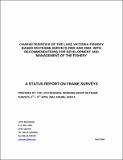Characteristics of the Lake Victoria fishery based on frame surveys 2000 and 2002: with recommendations for development and management of the fishery
Author
Date
2004Type
Reportviews
downloads
Metadata
Show full item recordxmlui.dri2xhtml.METS-1.0.item-citation
Characteristics of the Lake Victoria fishery based on frame surveys 2000 and 2002: with recommendations for development and management of the fishery
Abstract/
Lake Victoria is the second largest freshwater body in the World. The lake has a surface area of 68,800 km2 of which 35,088 km2 (51%) is in Tanzania, Uganda 29,584 km2 (43%) is in Uganda, and 4,128 km2 is in Kenya 6%. It has a shoreline length of 3,450 km of which 1,150 km (33%) is in Tanzania, 1,750 km (51%) is in the Uganda and 550 km (16) is in the Kenya. The lake has a catchment of 194,200 km2 with a rapidly growing population of over 30 million people Lake Victoria is very important to the economies of the East African Community (EAC) Partner States. It is the most productive fishery in Africa, with an annual fish landing of 500,000 metric tons. The fishery is valued at US$ 600 million locally with exports, which were valued at US$ 217 million annually by 2001. It provides high protein food, employment, income, and clean water for domestic and industrial use. It had high fish species diversity of economic and ecological importance and is used as an avenue for transport, recreation and power generation The dynamics of the fishery of Lake Victoria has changed dramatically since the emergence of the Nile perch fishery in the late 1970s and the subsequent evolution of fish processing for export. The incentive created by the ready market by the fish processing plants has fuelled rapid increase in fishing effort. Fish export is a major foreign exchange earner of the Partner States and efforts have been made to ensure sustainability of this resource. Relevant parameters of the fishery are monitored to guide its development and management. Frame survey is one of the avenues through which the Partner States are monitoring the fishery resource

